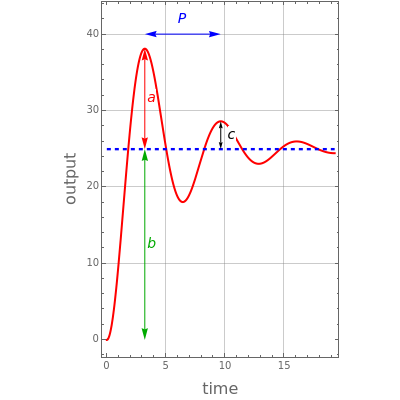Performance Characteristics for Step Response of an Underdamped Process
Performance Characteristics for Step Response of an Underdamped Process
Consider an underdamped second-order process with a transfer function (the ratio of output to input of a system), given by , where is the steady-state gain, is the time constant, and is the damping coefficient (with ). The process is subjected to a step input . This Demonstration shows plots of the response and finds its performance characteristics: overshoot , decay ratio , time to rise , time to first peak , and period of oscillations . You can vary the values of , , , and . Here, the values of are restricted to the interval in order to clearly identify , , , and in the plot of the output function .
G(s)=+2ζτs+1
K
g
2
τ
2
s
K
g
τ
ζ
0<ζ<1
U(t)=
M
s
y(t)=(G(s)U(s))
-1
ℒ
a/b
c/a
t
r
t
p
P
M
K
g
τ
ζ
ζ
[0.05,0.3]
a
b
c
P
y(t)
Details
Details
The overshoot is equal to .
a/b=exp-πζ
1-
2
ζ
The decay ratio is equal to .
c/a==exp-2πζ
2
(a/b)
1-
2
ζ
The period of oscillation is .
P=2πτ
1-
2
ζ
The time to first peak is given by =πτ.
t
p
1-
2
ζ
The rise time is the solution of and .
t
r
y()=M
t
r
K
g
0<<
t
r
t
p
References
References
[1] D. E. Seborg, T. F. Edgar, D. A. Mellichamp, and F. J. Doyle III, Process Dynamics and Control, 3rd ed., New York: Wiley, 2011.
Permanent Citation
Permanent Citation
Housam Binous, Mohammad Mozahar Hossain, Ahmed Bellagi
"Performance Characteristics for Step Response of an Underdamped Process"
http://demonstrations.wolfram.com/PerformanceCharacteristicsForStepResponseOfAnUnderdampedProc/
Wolfram Demonstrations Project
Published: October 26, 2015
